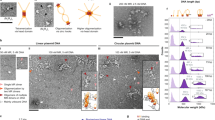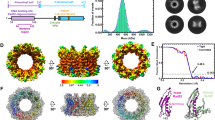Abstract
Rad51 protein plays an essential role in recombination repair of DNA double-strand breaks and DNA crosslinking adducts. It is part of complexes which can vary with the stage of the cell cycle and the nature of the DNA lesions. During a search for Rad51-associated proteins in CHO nuclear extracts of S-phase cells by mass spectrometry of proteins immunoprecipitated with Rad51 antibodies, we identified a centrosomal protein, γ-tubulin. This association was confirmed by the reverse immunoprecipitation with γ-tubulin antibodies. Both proteins copurified from HeLa cells nuclear extracts following a tandem affinity purification of double-tagged Rad51. Immunofluorescence analysis showed colocalization of both Rad51 and γ-tubulin in discrete foci in mammalian cell nuclei. The number of colocalized foci and their overlapping area increased in the presence of DNA damage produced by genotoxic treatments either during S phase or in exponentially growing cells. These variations did not result from an overall stress because microtubule cytoskeleton poisons devoid of direct interactions with DNA, such as taxol or colcemid, did not lead to an increase of this association. The recruitment of Rad51 and γ-tubulin in the same nuclear complex suggests a link between DNA recombination repair and the centrosome function during the cell cycle.
This is a preview of subscription content, access via your institution
Access options
Subscribe to this journal
Receive 50 print issues and online access
$259.00 per year
only $5.18 per issue
Buy this article
- Purchase on Springer Link
- Instant access to full article PDF
Prices may be subject to local taxes which are calculated during checkout




Similar content being viewed by others
References
Andersen JS, Lyon CE, Fox AH, Leung AK, Lam YW, Steen H, Mann M and Lamond AI . (2002). Curr. Biol., 12, 1–11.
Andersen JS, Wilkinson CJ, Mayor T, Mortensen P, Nigg EA and Mann M . (2003). Nature, 426, 570–574.
Arnaudeau C, Helleday T and Jenssen D . (1999). J. Mol. Biol., 289, 1231–1238.
Bertrand P, Lambert S, Joubert C and Lopez BS . (2003). Oncogene, 22, 7587–7592.
Biemann K . (1990). Methods Enzymol., 193, 886–887.
Buchhop S, Gibson MK, Wang XW, Wagner P, Sturzbecher HW and Harris CC . (1997). Nucleic. Acids Res., 25, 3868–3874.
Casenghi M, Meraldi P, Weinhart U, Duncan PI, Korner R and Nigg EA . (2003). Dev. Cell, 5, 113–125.
Ciciarello M, Mangiacasale R, Casenghi M, Zaira Limongi M, D'Angelo M, Soddu S, Lavia P and Cundari E . (2001). J. Biol. Chem., 276, 19205–19213.
Cox MM . (2002). Mutat. Res., 510, 107–120.
Davies AA, Masson JY, McIlwraith MJ, Stasiak AZ, Stasiak A, Venkitaraman AR and West SC . (2001). Mol. Cell., 7, 273–282.
Deng CX . (2002). Oncogene, 21, 6222–6227.
Dodson H, Bourke E, Jeffers LJ, Vagnarelli P, Sonoda E, Takeda S, Earnshaw WC, Merdes A and Morrison C . (2004). EMBO J., 23, 3864–3873.
Feng Y, Hodge DR, Palmieri G, Chase DL, Longo DL and Ferris DK . (1999). Biochem. J., 339 (Part 2), 435–442.
Fukushima T, Takata M, Morrison C, Araki R, Fujimori A, Abe M, Tatsumi K, Jasin M, Dhar PK, Sonoda E, Chiba T and Takeda S . (2001). J. Biol. Chem., 276, 44413–44418.
Griffin CS, Simpson PJ, Wilson CR and Thacker J . (2000). Nat. Cell. Biol., 2, 757–761.
Haaf T, Golub EI, Reddy G, Radding CM and Ward DC . (1995). Proc. Natl. Acad. Sci. USA, 92, 2298–2302.
Haaf T, Raderschall E, Reddy G, Ward DC, Radding CM and Golub EI . (1999). J. Cell. Biol., 144, 11–20.
Herreros L, Rodriguez-Fernandez JL, Brown MC, Alonso-Lebrero JL, Cabanas C, Sanchez-Madrid F, Longo N, Turner CE and Sanchez-Mateos P . (2000). J. Biol. Chem., 275, 26436–26440.
Hsu LC and White RL . (1998). Proc. Natl. Acad. Sci. USA, 95, 12983–12988.
Hung LY, Tang CJ and Tang TK . (2000). Mol. Cell. Biol., 20, 7813–7825.
Hut HM, Lemstra W, Blaauw EH, Van Cappellen GW, Kampinga HH and Sibon OC . (2003). Mol. Biol. Cell., 14, 1993–2004.
Job D, Valiron O and Oakley B . (2003). Curr. Opin. Cell. Biol., 15, 111–117.
Julian M, Tollon Y, Lajoie-Mazenc I, Moisand A, Mazarguil H, Puget A and Wright M . (1993). J. Cell. Sci, 105, 145–156.
Korver W, Guevara C, Chen Y, Neuteboom S, Bookstein R, Tavtigian S and Lees E . (2003). Int. J. Cancer, 104, 283–288.
Kraakman-van der Zwet M, Overkamp WJ, van Lange RE, Essers J, van Duijn-Goedhart A, Wiggers I, Swaminathan S, van Buul PP, Errami A, Tan RT, Jaspers NG, Sharan SK, Kanaar R and Zdzienicka MZ . (2002). Mol. Cell. Biol., 22, 669–679.
Kukharskyy V, Sulimenko V, Macurek L, Sulimenko T, Draberova E and Draber P . (2004). Exp. Cell. Res., 298, 218–228.
Lajoie-Mazenc I, Tollon Y, Detraves C, Julian M, Moisand A, Gueth-Hallonet C, Debec A, Salles-Passador I, Puget A, Mazarguil H, Raynaud-Messina B and Wright M . (1994). J. Cell. Sci, 107, 2825–2837.
Lambert S and Lopez BS . (2000). EMBO J., 19, 3090–3099.
Linke SP, Sengupta S, Khabie N, Jeffries BA, Buchhop S, Miska S, Henning W, Pedeux R, Wang XW, Hofseth LJ, Yang Q, Garfield SH, Sturzbecher HW and Harris CC . (2003). Cancer Res., 63, 2596–2605.
Lisby M, De Mayolo AA, Mortensen UH and Rothstein R . (2003). Cell. Cycle, 2, 479–483.
Maacke H, Opitz S, Jost K, Hamdorf W, Henning W, Kruger S, Feller AC, Lopens A, Diedrich K, Schwinger E and Sturzbecher HW . (2000). Int. J. Cancer, 88, 907–913.
Margulis TN . (1974). J. Am. Chem. Soc., 96, 899–902.
Moynahan ME, Cui TY and Jasin M . (2001a). Cancer Res., 61, 4842–4850.
Moynahan ME, Pierce AJ and Jasin M . (2001b). Mol. Cells., 7, 263–272.
Pellegrini L, Venkitaraman A, Conway AB, Lynch TW, Zhang Y, Fortin GS, Fung CW, Symington LS and Rice PA . (2004). Trends Biochem. Sci., 29, 310–316.
Puig O, Caspary F, Rigaut G, Rutz B, Bouveret E, Bragado-Nilsson E, Wilm M and Seraphin B . (2001). Methods, 24, 218–229.
Rigaut G, Shevchenko A, Rutz B, Wilm M, Mann M and Seraphin B . (1999). Nat. Biotechnol., 17, 1030–1032.
Rios RM, Sanchis A, Tassin AM, Fedriani C and Bornens M . (2004). Cell, 118, 323–335.
Saintigny Y, Delacote F, Vares G, Petitot F, Lambert S, Averbeck D and Lopez BS . (2001). EMBO J., 20, 3861–3870.
Schiff PB, Fant J and Horwitz SB . (1979). Nature, 277, 665–667.
Scully R, Chen J, Ochs RL, Keegan K, Hoekstra M, Feunteun J and Livingston DM . (1997). Cell, 90, 425–435.
Sonoda E, Sasaki MS, Buerstedde JM, Bezzubova O, Shinohara A, Ogawa H, Takata M, Yamaguchi-Iwai Y and Takeda S . (1998). EMBO J., 17, 598–608.
Starita LM, Machida Y, Sankaran S, Elias JE, Griffin K, Schlegel BP, Gygi SP and Parvin JD . (2004). Mol. Cell. Biol., 24, 8457–8466.
Stearns T, Evans L and Kirschner M . (1991). Cell, 65, 825–836.
Takada S, Kelkar A and Theurkauf WE . (2003). Cell, 113, 87–99.
Takahashi M, Yamagiwa A, Nishimura T, Mukai H and Ono Y . (2002). Mol. Biol. Cell., 13, 3235–3245.
Tan TL, Essers J, Citterio E, Swagemakers SM, de Wit J, Benson FE, Hoeijmakers JH and Kanaar R . (1999). Curr. Biol., 9, 325–328.
Tarsounas M, Davies D and West SC . (2003). Oncogene, 22, 1115–1123.
Tashiro S, Kotomura N, Shinohara A, Tanaka K, Ueda K and Kamada N . (1996). Oncogene, 12, 2165–2170.
Tashiro S, Walter J, Shinohara A, Kamada N and Cremer T . (2000). J. Cell. Biol., 150, 283–291.
Thompson HM, Cao H, Chen J, Euteneuer U and McNiven MA . (2004). Nat. Cell. Biol., 6, 335–342.
Tsuzuki T, Fujii Y, Sakumi K, Tominaga Y, Nakao K, Sekiguchi M, Matsushiro A, Yoshimura Y and MoritaT . (1996). Proc. Natl. Acad. Sci. USA, 93, 6236–6240.
Tutt A and Ashworth A . (2002). Trends Mol. Med., 8, 571–576.
Venkitaraman AR . (2002). Cell, 108, 171–182.
Vispe S, Cazaux C, Lesca C and Defais M . (1998). Nucleic. Acids Res., 26, 2859–2864.
Wiese C and Zheng Y . (1999). Curr. Opin. Struct. Biol., 9, 250–259.
Wilm M, Shevchenko A, Houthaeve T, Breit S, Schweigerer L, Fotsis T and Mann M . (1996). Nature, 379, 466–469.
Yoshikawa K, Ogawa T, Baer R, Hemmi H, Honda K, Yamauchi A, Inamoto T, Ko K, Yazumi S, Motoda H, Kodama H, Noguchi S, Gazdar AF, Yamaoka Y and Takahashi R . (2000). Int. J. Cancer, 88, 28–36.
Yuan SS, Lee SY, Chen G, Song M, Tomlinson GE and Lee EY . (1999). Cancer Res., 59, 3547–3551.
Zhao J, Ren Y, Jiang Q and Feng J . (2003). J. Cell. Sci., 116, 4011–4019.
Acknowledgements
We gratefully acknowledge Dr NP Johnson for critical reading of the manuscript, A Moisand for EM and F Viala for iconography. This work was supported by a grant from Ligue régionale de recherche sur le cancer Midi-Pyrénées (to MD), a grant from the Association de recherche contre le cancer (MW) and a grant from the ARECA network of Association de recherche contre le cancer to MD, MW and BM and from Région Midi-Pyrénées (BM).
Author information
Authors and Affiliations
Corresponding author
Rights and permissions
About this article
Cite this article
Lesca, C., Germanier, M., Raynaud-Messina, B. et al. DNA damage induce γ-tubulin–RAD51 nuclear complexes in mammalian cells. Oncogene 24, 5165–5172 (2005). https://doi.org/10.1038/sj.onc.1208723
Received:
Revised:
Accepted:
Published:
Issue Date:
DOI: https://doi.org/10.1038/sj.onc.1208723
Keywords
This article is cited by
-
The γ-tubulin meshwork assists in the recruitment of PCNA to chromatin in mammalian cells
Communications Biology (2021)
-
Tubulin is actively exported from the nucleus through the Exportin1/CRM1 pathway
Scientific Reports (2019)
-
The GTPase domain of gamma-tubulin is required for normal mitochondrial function and spatial organization
Communications Biology (2018)
-
γ-tubulin as a signal-transducing molecule and meshwork with therapeutic potential
Signal Transduction and Targeted Therapy (2018)
-
Such small hands: the roles of centrins/caltractins in the centriole and in genome maintenance
Cellular and Molecular Life Sciences (2012)



